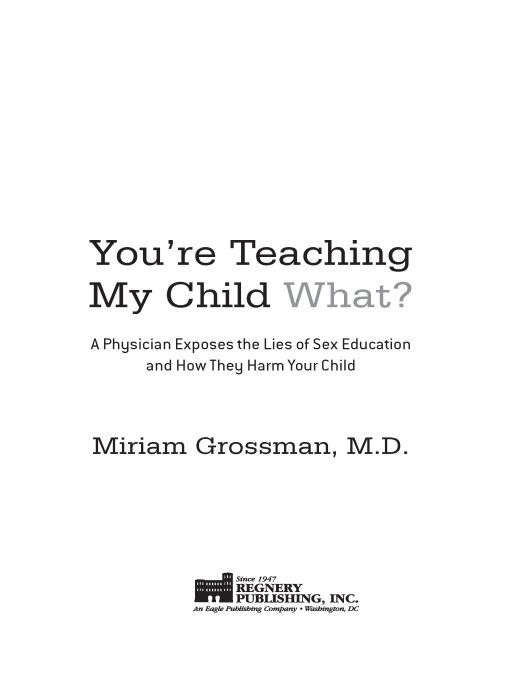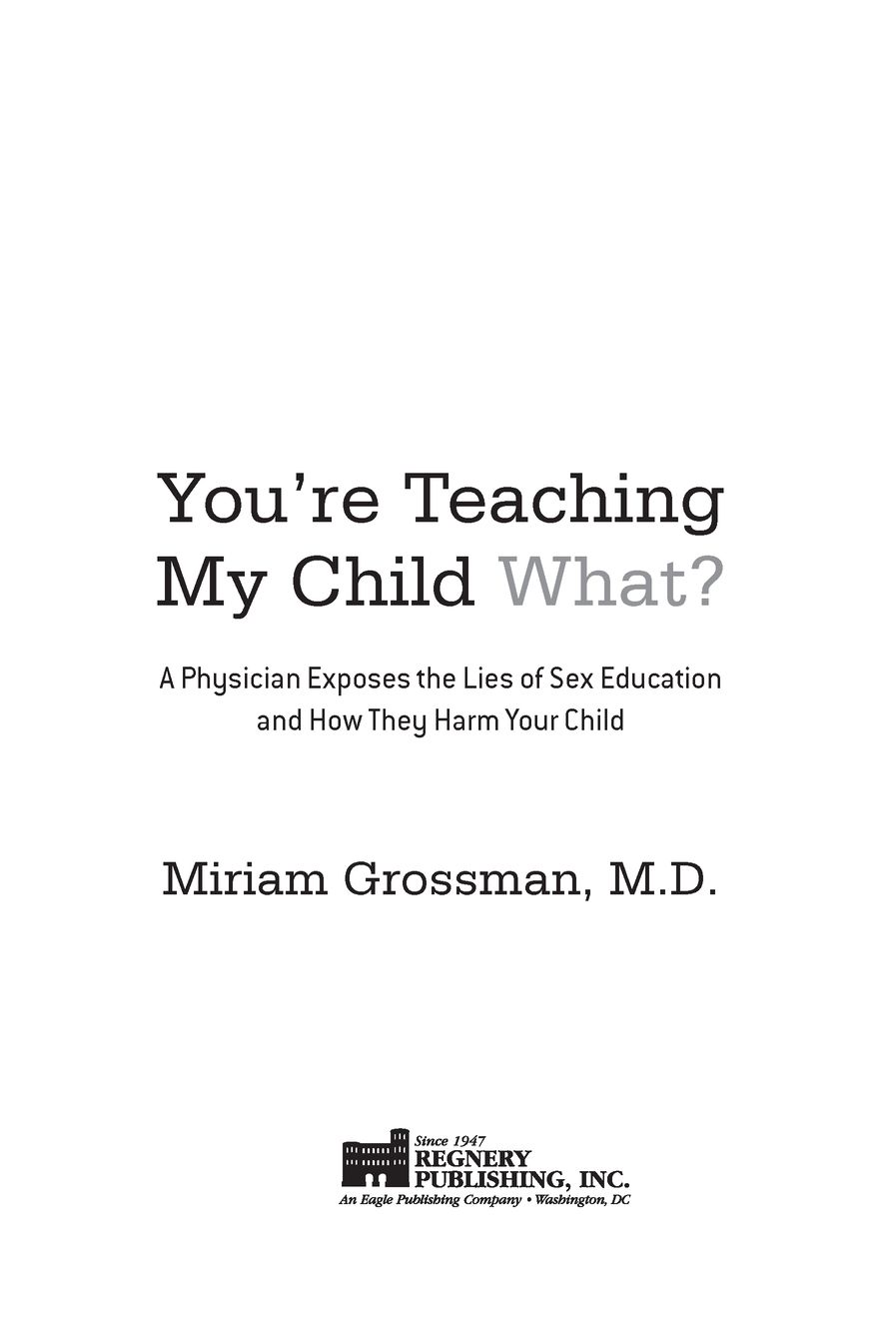You're Teaching My Child What?
Read You're Teaching My Child What? Online
Authors: Miriam Grossman


Table of Contents
Â
Â
Â
Â
Â
Â
Â
Â
Â

Truth does not become more true by virtue of the fact that the entire world agrees with it, nor less so even if the whole world disagrees with it.
Â
âMoses Maimonides,Guide for the Perplexed

Introduction:
Shocked
H
AVE YOU EVER CROSSED PATHS with someone momentarily, exchanged a few words, and then discovered you can't forget their face, or something they said? That's what I'm going through now. Several months ago, I gave a talk about sexual health to college students, and a girl in the audience made an astonishing comment. Her words, and her eyes, haunt me to this day.
AVE YOU EVER CROSSED PATHS with someone momentarily, exchanged a few words, and then discovered you can't forget their face, or something they said? That's what I'm going through now. Several months ago, I gave a talk about sexual health to college students, and a girl in the audience made an astonishing comment. Her words, and her eyes, haunt me to this day.
I'd been invited to speak at a small private college outside Philadelphia. The auditorium was filled to capacity, with students sitting in the aisles and leaning against the walls. It was a lively crowd, but when I stepped up to the podium it fell silent.
They knew I wasn't there with another “safer sex” talk. Why fly me in from across the country to tell them things they can recite in their sleep? They invited me because I'm the doctor bringing the science they'd never heard. The biochemistry of trust and attachment. How ovulation is affected by a man's scent. Why a young cervix is easily infected. They'd learn that evening that with or without protection,
sex is a serious matterâespecially for girls. That a single encounter can have profound, life-long consequences.
sex is a serious matterâespecially for girls. That a single encounter can have profound, life-long consequences.
I was there to teach the biology that was omitted from their “safer sex” training. It was a no-nonsense, politically incorrect approach to a subject close to their hearts, and they hung on to each word from start to finish.
Afterwards I asked for questions, and a number of hands shot up.
“What about the HPV vaccine?”
“There's reason to hope it will prevent a great deal of disease,” I said, “but it's not a cure-all. Girls,” I told them, “you should be vaccinated even if you've already been sexually active.”
Next came a complaint:
“You assume everyone is heterosexual. You should be less hetero-normative.”
This was not the right time for a discussion about the politically correct notion of “heteronormality,” so I just thanked the student for his comment and added that the highest rates of sexually transmitted infections are found in gay men and bisexuals, and the lowest in lesbians.
1
1
Then a dark-haired girl in the front row raised her hand.
“I'm a perfect example of what you talked about. I always used condoms, but I got HPV anyway, and it's one of the high-risk types. I had an abnormal Pap test, and next week I'm going to have a culposcopy.”
She sounded mellow, but there was panic in her eyes.
I felt a wave of sorrow. This young woman was going in for a biopsy of her cervix because atypical cells were presentâa result of infection with a high risk strain of HPV. I knew what that meant: she probably had HPV-16, the type that's most difficult for her body to clear,
2
and most likely to cause malignancy. If the infection persisted, her risk of developing cervical cancer was at least 40 percent.
3
2
and most likely to cause malignancy. If the infection persisted, her risk of developing cervical cancer was at least 40 percent.
3
“But I thought it over,” she continued, “and I decided that the pleasure I had with my partners was worth it.”
The audience was silent. How does one react to such a declaration? With applause? High fives?
“I hope all goes well next week,” I said, “and that you'll never have to worry about this again.”
But I knew it wasn't so simple. In a few days she'll lie on a table with her feet in stirrups, a large electronic microscopic inches from her vagina. With a bright light illuminating the site, the gynecologist will examine her cervix. He'll say something like “this might be uncomfortable,” then excise abnormal areas with a scalpel. It will hurt. She might have pain and discharge afterwards. Then she'll wait for a call with the results: is she okay, or not?
The way I saw it, her story was a double catastrophe. For a young womanâshe couldn't have been over 20âto even
worry
about having cancer was the first catastrophe. At this time in her life, she shouldn't be concerned about anything more serious than finals.
worry
about having cancer was the first catastrophe. At this time in her life, she shouldn't be concerned about anything more serious than finals.
The second catastrophe was her sentiment: “The pleasure I had was worth it.”
Worth it?
What's she talking about?
What's she talking about?
Didn't she have the concerns I always hear:
When was I infected, last week or last year?
and
Who was it, Kenny or Ron? Should I tell my current partner, or my future ones? What about Mom and Dad? What does dysplasia mean, anyhow? Could I really get . . .
cancer
?
When was I infected, last week or last year?
and
Who was it, Kenny or Ron? Should I tell my current partner, or my future ones? What about Mom and Dad? What does dysplasia mean, anyhow? Could I really get . . .
cancer
?
Was this young woman aware, I wondered, of all the possible ramifications? While it's true that most HPV seems to clear, she'll never knowâis the virus gone, or just dormant? Had anyone told her that having one sexually transmitted disease (STD) makes her more vulnerable to others, including HIV? That being on the pill could increase her risk, and that pregnancy can re-activate the virus?
All this, yet “the pleasure was worth it”?
I guess she felt that sex trumps everything, even health. It was all about pleasure, even if it ends in disease. Where did this thinking come from?
Back to the SourceAccording to a 2008 report from the federal Centers for Disease Control, she has plenty of company: one in four adolescent girls in the United States has a sexually transmitted infection.
4
When that fact hit the news, parents were horrified, health experts were shocked, and the CDC called it “a wake-up call.”
5
4
When that fact hit the news, parents were horrified, health experts were shocked, and the CDC called it “a wake-up call.”
5
A statement was issued by the president of the Sexuality Information and Education Council of the United States (SIECUS). The figures, it said, were “staggering” and “disturbing”; they represented an “inexcusable failure.”
6
6
Their reaction reminded me of a scene in the classic film
Casablanca
. You know, that famous line in which Captain Renault tells Rick he is “shockedâ
shocked!
âto find that gambling is going on in here,” and then quietly collects his winnings.
Casablanca
. You know, that famous line in which Captain Renault tells Rick he is “shockedâ
shocked!
âto find that gambling is going on in here,” and then quietly collects his winnings.
One in two sexually active youth will contract an STD by age 25.
29
29
That 3.2
7
million American girls have a sexually transmitted infection should come as no shock, especially to SIECUS and its main cohorts, Advocates For Youth (AFY) and Planned Parenthood. This pandemic is a direct consequence of their vision and ideals.
7
million American girls have a sexually transmitted infection should come as no shock, especially to SIECUS and its main cohorts, Advocates For Youth (AFY) and Planned Parenthood. This pandemic is a direct consequence of their vision and ideals.
These groups claim to provide “comprehensive access” to “accurate” sex education. Take a look, though, at their curricula, their guides for teachers and parents, andâmost disturbingâthe websites to which they direct your kids: you'll see how young people are infused with a grotesque exaggeration of the place of sexuality. Promiscuity, experimentation, and fringe behaviors are encouraged. For them, these are personal choices, and judgments are prohibited. At all ages, sexual freedom is a “right,” an issue of social justice. In short, they are dedicated to promoting radical social ideologies, not preventing disease.
That one in four teens has a sexually transmitted infection (STI) is deeply troubling, yes, but it shouldn't come as a surprise. What's astonishing is the madness called “sexuality education.” Until these programs are recognized as irresponsible and dishonest, young people, especially girls, will continue to pay an awful price.
Sex education is comprised of a vast network of programs with Planned Parenthood, Advocates for Youth, and SIECUS at its center. Consequently, every parent should check their child's school curricula for the full picture.
Madness is a strong word, but the more I learn
what
our children are taught, and
when
, the more I stand by that choice.
what
our children are taught, and
when
, the more I stand by that choice.
Parents, have you heard what our kids are told? Have you seen what's put in front of them? I thought it was
illegal
to make indecent material available to minors. You think MTV is vulgar? I suggest you explore the material sex educators have created for kids.
illegal
to make indecent material available to minors. You think MTV is vulgar? I suggest you explore the material sex educators have created for kids.
Other books
The Naked Face by Sheldon, Sidney
The Relic Murders by Paul Doherty
The Savage King by Michelle M. Pillow
Wicked Fantasy by Nina Bangs
Falling for Her Husband by Karen Erickson
Silent Son by Gallatin Warfield
You Belong To Me by Ursula Dukes
Whispers From The Abyss by Kat Rocha (Editor)
Caught in the Light by Robert Goddard
Poachers by Tom Franklin
